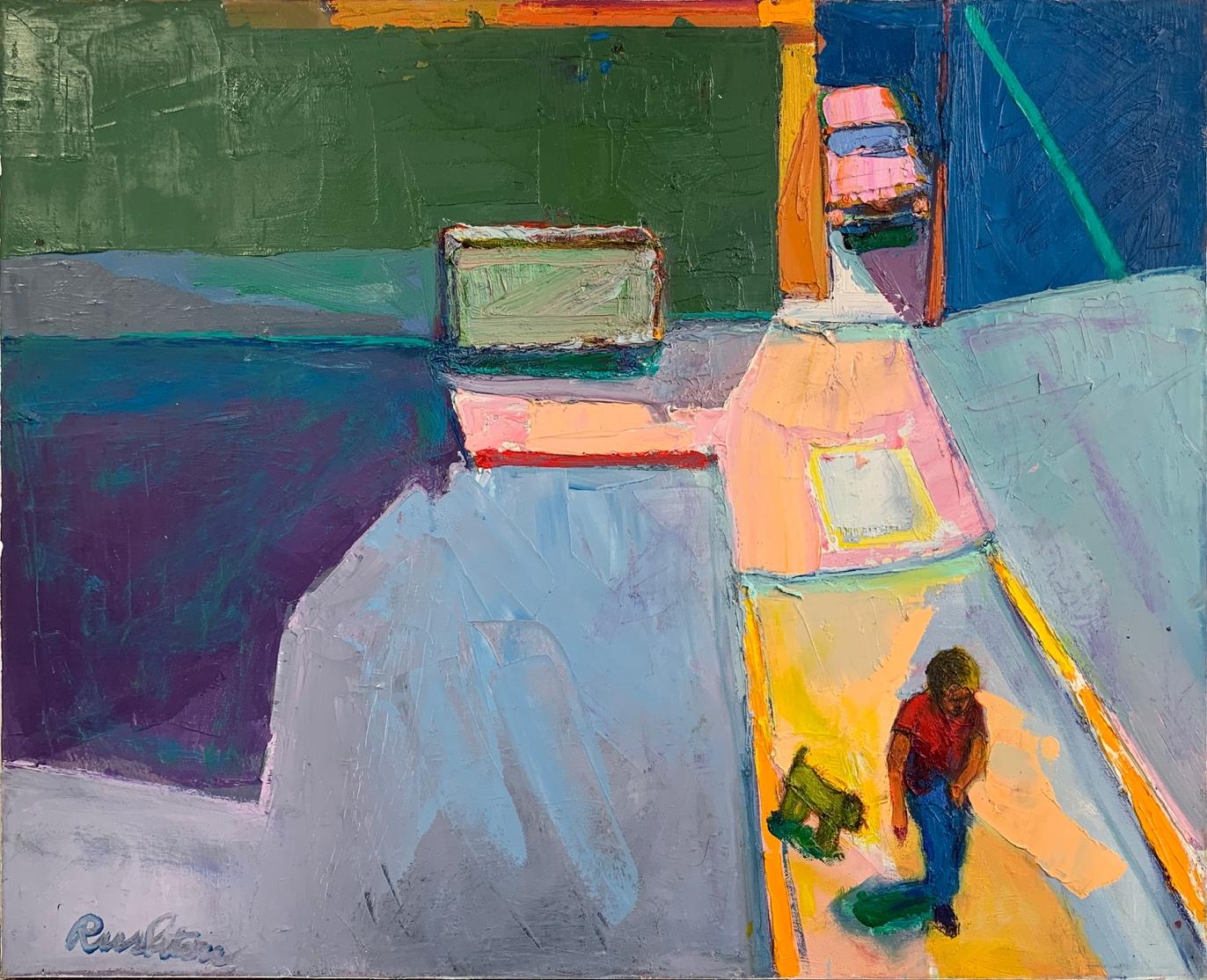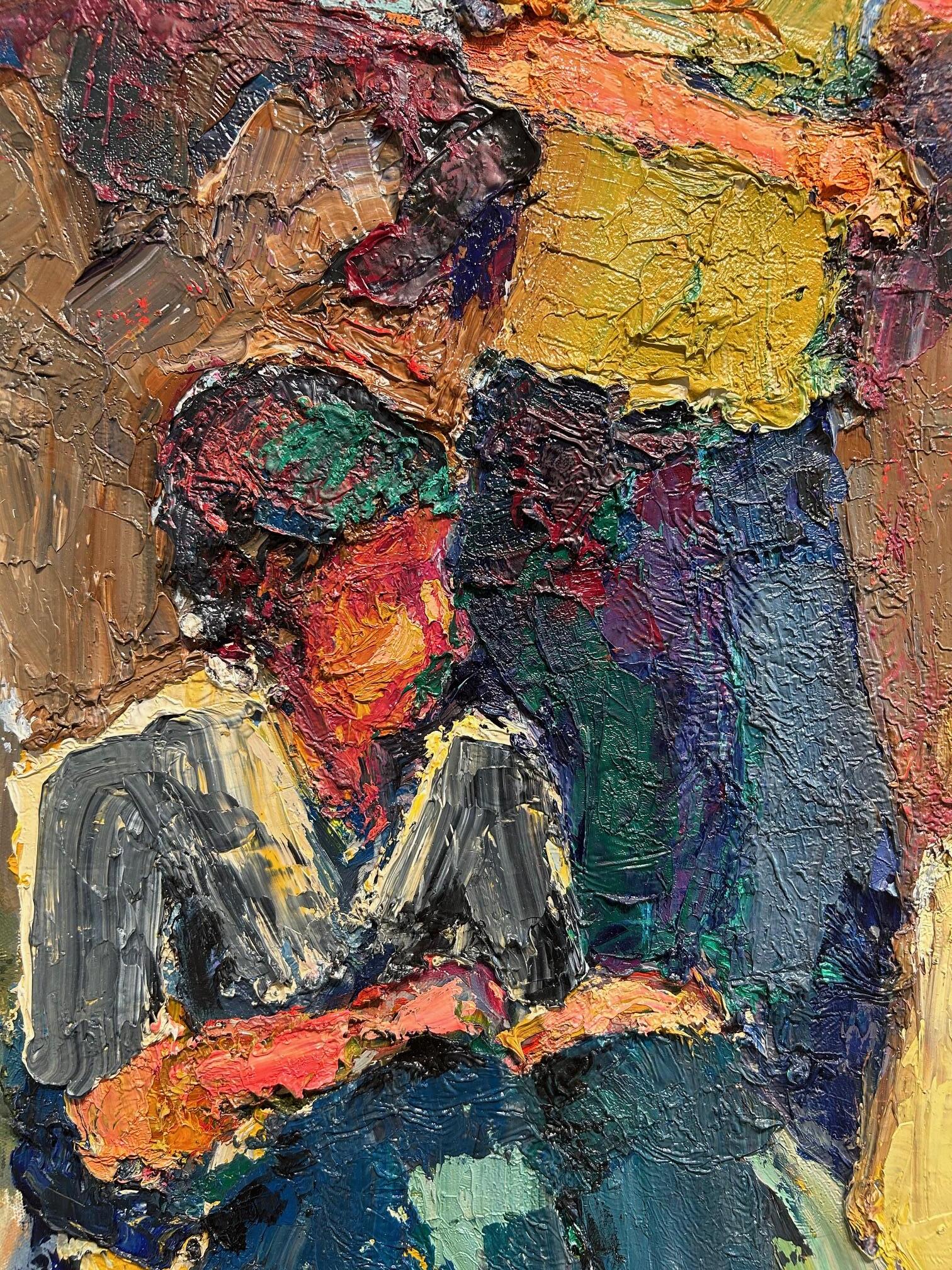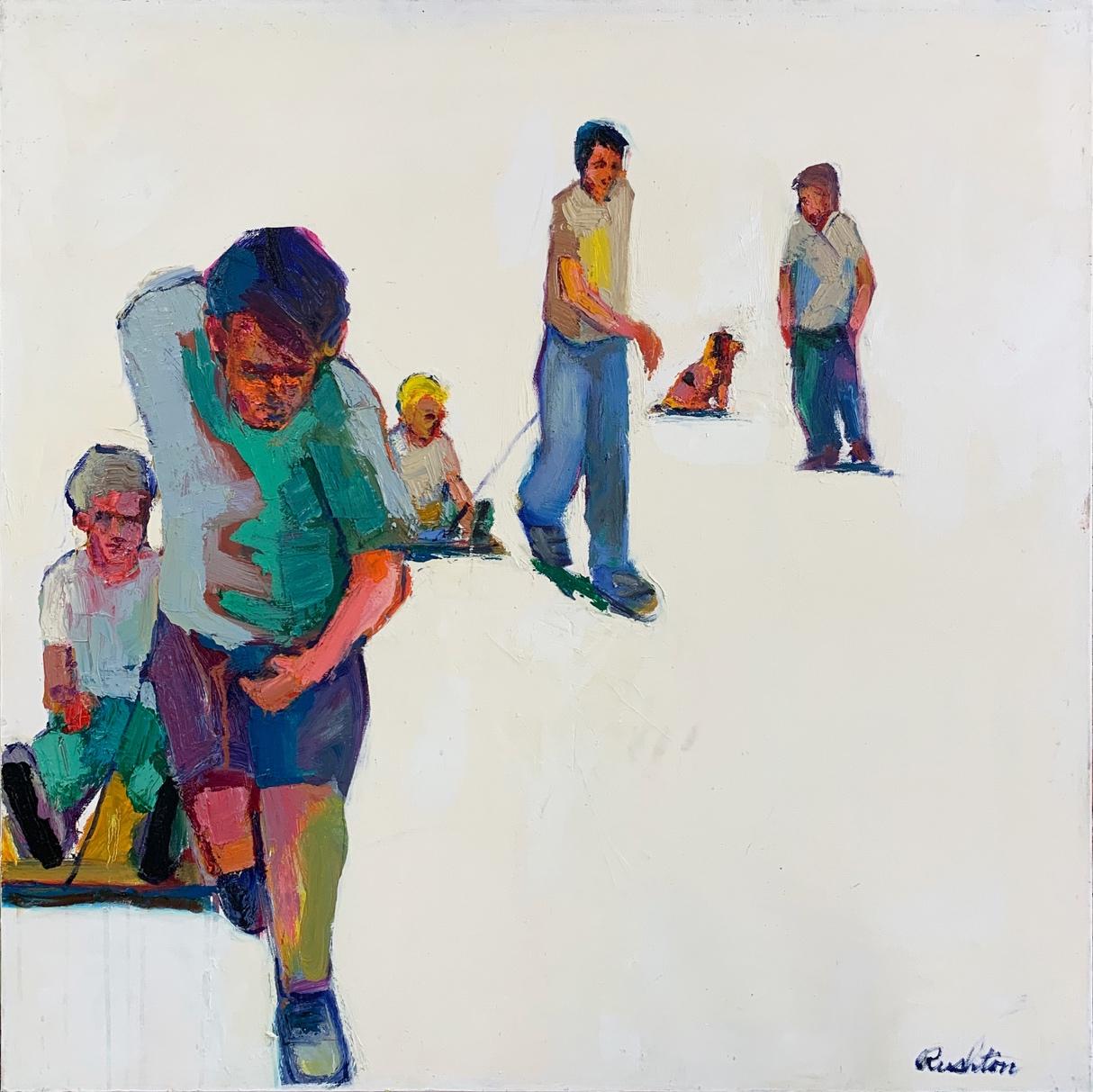WILLIAM RUSHTON



October 3rd – November 20th, 2024
Bryant Street Gallery is excited to present A Dog and Pony Show, a brand new exhibition by William Rushton. This series of figurative works showcases Rushton testing the limits of his subject matter, delivering everyday scenes in luscious textures and lurid palettes. The exhibit is on display from October 3rd to November 30th, 2024. The gallery and artist welcome the public to an opening reception on Saturday, October 19th, from 3-5 p.m.
Rushton is a master at capturing unexpected colors. In Rushton’s world, shadows are vibrant greens and purples; skin tones are fuchsia and bright orange; and the sky is pink or yellow, yet the colors harmonize to create a believable image. He employs heavy application of paint to the point where it is dripping and pushing forward out of the canvas, like a whimsical raised relief map. Mountains of pigment emphasize the focal points while layers of a multitude of underpaintings peek through the crevasses and valleys of the brush and knife work.
Though form, color, and composition are Rushton’s primary concerns, his pieces have an undeniably narrative aspect to them as well. He portrays biographical stories of daily American life: people tending to their animal friends, children playing made-up games, a boat drifting aimlessly on the waves. A visit to his studio reveals a particular fascination with dogs and horses– prominent features in the quintessential American experience–and the roles they play in our lives. Despite A Dog and Pony Show shining a spotlight on specific thematic elements, Rushton still emphasizes the importance of craft: “The figure and/or landscape serve as points of departure. What I paint is not as important as how I paint.” Indeed, it is his technique that makes these scenes feel so alive.
The many layers of paint on Rushton’s canvases reflect the many layers of artistic styles he has learned from and mastered. In the 1960s, he moved from London to the Bay Area to study art. He started out, unexpectedly, creating large environmental sculptures. From there, he became a photorealist, rendering cars and regular people in painstaking detail. In the 1990s, he discovered the “Society of Six,” a renowned group of San Francisco plein-air painters, which led him to become immersed in the community. He maintained this loose painting style, but eventually readopted the sense of narrative his previous paintings had communicated.
Today, this deep, winding history is reflected in A Dog and Pony Show: the sculptural element of the paint, layered on so thick it protrudes from the canvas; the fascination with the everyday, making mundanity pulse with life; and the intuitive brushwork of plein-air painters and their veneration for working from life to capture the essence of the subject.
Rushton continues to work and live in the San Francisco Bay Area. His works can be found in collections all over the country, including the Bolinas Museum of Art, the Triton Museum of Art, Manuel Neri, John Modell, and Mary Bromwell.
A Dog and Pony Show is on view at 532 Bryant Street, Palo Alto, CA 94301 from October 3rd to November 30th. For more images and information please visit the website at www.bryantstreet.com or email us at bryantst@mac.com.
Bio:
William began his art career creating large environmental sculptures in the late 1960s and early 1970s. His work was exhibited at San Jose State University, Works Gallery, San Jose Institute of Contemporary Art, and Villa Montalvo, among other local venues. His focus shifted in the 1980s towards painting, specifically photorealistic work of vintage cars, regular folks and California neighborhoods.
A chance visit to a local gallery in 1990 introduced him to the landscape paintings of Jerrold Turner. Turner had painted with Louis Siegriest, a renowned California Impressionist and his son Lundy. Siegriest was a member of the “Society of Six,” a 20th century group of plein-air painters which included Selden Gile, August Gay, William Clapp, Maurice Logan and Bernard von Eichman. All became influences on William as he shed the restraints of photo-realism and launched into painting plein-air.
Through Turner, William met and began painting with other plein-air painters in the San Francisco Bay Area. On a 1998 painting trip to Inverness, William, with fellow painters Nikki Basch-Davis and Jerrold Turner, began talking about forming a group comprised of painting comrades, and “The Outsiders” was born. This group later expanded to include Pam Glover, who also painted with Siegriest, Judy Molyneux, Randall Sexton and Ray Jackson.
Today, William’s work has moved away from pure plein-air landscape painting to work which includes the figure. There is a strong sense of narrative in his work. He paints in a loose and immediate style, and continues to be inspired by the “Society of Six” and the Bay Area Figurative School.
William continues to paint plein-air, but spends more time in the studio, especially when the seasons begin to change. He uses memory and photographs as points of departure, and readily admits that working plein-air complements and invigorates his work in the studio.
William has taught plein-air painting through the University of California, and spent thirty-seven years teaching painting and drawing at Cupertino High School. He is now retired and painting full time as well as teaching workshops and privately.
William is represented by Jennifer Perlmutter Gallery in Lafayette, Bryant Street Gallery in Palo Alto, and has works available at John Natsoulas Gallery in Davis, CA. William’s work can also be seen at Hawk Gallery in Columbus, OH.
His work appears in many collections including Bolinas Museum of Art, Triton Museum of Art, Manuel Neri, John Modell, Mary Bromwell, Preston Butcher, and Barbara Simmons.
Artist Statement:
My work has always been a colorist’s view, whether figurative or landscape. I work plein-air and in the studio, and feel that one approach complements the other. In recent years my explorations have taken me in an abstract and figurative direction. The figure and/or landscape serve as points of departure. What I paint is not as important as how I paint. I paint in order to find a painting. Surrendering and listening to what the painting is trying to tell me is paramount. The subject sometimes feels like a necessary evil, serving as a temporary way to organize subsequent shapes and colors. It’s almost as if the subject is an incidental by-product of the painting process, not sacred, and subject to sacrifice. This is not to say that the subject is unrecognizable or unnecessary, but that it is vulnerable to shift and change. Moving from point A to point B in a linear manner feels like a dead-end trap.
Mistakes create new marks and new directions for me. They sometimes feel like the life-blood of the process. I see myself not so much a recorder of what I see, but a responder to what I’ve seen. My most satisfying work is done when I am able to paint faster than I can think. I don’t always know where I’m going, but I know how to get there. Not knowing where it is all going keeps me inspired and pushing forward. Facilitating endless discoveries is a vital part of that push.
























